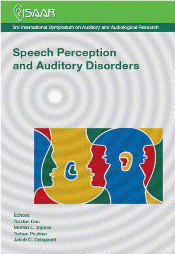Assessment of auditory processing in children demonstrating symptoms of (Central) Auditory processing disorder (C)APD
Abstract
(Central) auditory processing describes functions such as sound localization and lateralization; auditory discrimination; auditory pattern recognition; temporal aspects of audition (e.g., temporal gap detection), temporal ordering, and temporal masking; auditory performance in competing acoustic signals (including dichotic listening); and auditory performance with degraded acoustic signals. Poor performance in one or more of these abilities without signs of degraded abilities of higher order cognitive/communicative and/or language-related functions might be a symptom for (Central) Auditory processing disorder, (C)APD. For school- aged children, (C)APD can manifest itself in difficulties in learning, speech, language, social, and related functions. However, depending on individual combinations of “bottom-up” and “top-down” abilities, the same aspect of auditory processing deficit may influence different children in different ways, which makes standardised ways of a diagnostic approach difficult to establish. During the last two years, a multidisciplinary team at Uppsala University Hospital has worked on diagnosis and management of children demonstrating symptoms of (C)APD. Results of measurements of auditory processing of 50 children as well as approaches to manage their problems are presented and discussed.
References
Bamiou D.E., Musiek F.E., Stow I., Stevens J., Cipolotti L., Brown M.M. and Luxon L.M.. (2006). “Auditory temporal processing deficits in patients with insular stroke” Neurology. 67, 614-9.
Bellis, T.J. (2003). “Assessment and Management of Central Auditory Processing Disorders in the Educational Setting From Science to Practice” 2nd ed. New York, Delmar Cengage Learning, pp.252-253
Carter, A. S., Noe, C. M. and Wilson, R. H. (2001). “Listeners who prefer monaural to binaural hearing aids” J. Am. Acad. Audiol., 12, 261-72.
Efron, R., Yund, E., Nichols, D., and Crandall, P. (1985). “An ear asymmetry for gap detection following anterior temporal lobectomy” Neuropsychologia, 23, 43–50.
Hällgren M, Johansson M, Larsby B, Arlinger S. (1998). ”Dichotic Speech Tests” Scand. Audiol. 27, Suppl 49, 35-39 rd
Johnston, K.N., John, A.B., Kreisman, N.V., Hall, J.W. 3 and Crandell, C.C. (2009). “Multiple benefits of personal FM system use by children with auditory processing disorder (APD)” Int. J. Audiol. 48, 371-83.
Köbler, S., Lindblad, A.C., Olofsson, Å., and Hagerman, B. (2010). ”Successful and unsuccessful users of bilateral amplification: Differences and similarities in binaural performance“ Int. J. Audiol. 49, 613-627
Logue-Kennedy, M., Lyons, R., Carroll, C., Byrne, M., Dignan, E., and O'Hagan, L. (2011). “Services for children with central auditory processing disorder in the republic of Ireland: current and future service provision” Am. J. Audiol. 20, 9- 18. Epub 2011 Apr 7.
Moore, D.R. (2006). “Auditory processing disorder (APD): Definition, diagnosis, neural basis, and intervention“ Audiological Medicine. 4, 4-11
Moore, D.R., Ferguson, M.A., Edmondson-Jones, A.M., Ratib, S., and Riley, A. (2010). “Nature of Auditory Processing Disorder in Children” Pediatrics 126, e382-e390
Musiek, F.E. (2005). “GIN (Gaps-In-Noise) test performance in subjects with confirmed central auditory nervous system involvement” Ear Hear. 26, 608-618
Musiek, F. E., Shinn, J. B., Jirsa, R., Bamiou, D. E., Baran, J. A., and Zaida, E. (2005). ”GIN (Gaps-In-Noise) test performance in subjects with confirmed central auditory nervous system involvement” Ear Hear. 26, 608-18.
Putter-Katz, H., Adi-Bensaid, L,, Feldman, I., and Hildesheimer, M. (2008). “Effects of speech in noise and dichotic listening intervention programs on central auditory processing disorders” J. Basic Clin. Physiol. Pharmacol. 19, 301-16.
Sharma, M.., Purdy, S.C.., and Kelly A.S. (2009). “Comorbidity of Auditory Processing, Language, and Reading Disorders” J. Speech Lang. Hear. Res. 52, 706-722
Shinn, J.B., Chermak, G.D., and Musiek, F.E. (2009). “GIN (Gaps-In-Noise) Performance in the Pediatric Population” J. Am. Acad. Audiol. 20, 229-238
Syka, J., Rybalko, N., Mazelova, J., and Druga, R. (2002).” Gap detection threshold in the rat before and after auditory cortex ablation” Hear. Res., 172, 151–159. Witton, C. (2010). “Childhood auditory processing disorder as a developmental disorder: the case for a multi-professional approach to diagnosis and management” Int. J. Audiol. 49, 83-7.
Additional Files
Published
How to Cite
Issue
Section
License
Authors who publish with this journal agree to the following terms:
a. Authors retain copyright* and grant the journal right of first publication with the work simultaneously licensed under a Creative Commons Attribution License that allows others to share the work with an acknowledgement of the work's authorship and initial publication in this journal.
b. Authors are able to enter into separate, additional contractual arrangements for the non-exclusive distribution of the journal's published version of the work (e.g., post it to an institutional repository or publish it in a book), with an acknowledgement of its initial publication in this journal.
c. Authors are permitted and encouraged to post their work online (e.g., in institutional repositories or on their website) prior to and during the submission process, as it can lead to productive exchanges, as well as earlier and greater citation of published work (See The Effect of Open Access).
*From the 2017 issue onward. The Danavox Jubilee Foundation owns the copyright of all articles published in the 1969-2015 issues. However, authors are still allowed to share the work with an acknowledgement of the work's authorship and initial publication in this journal.


